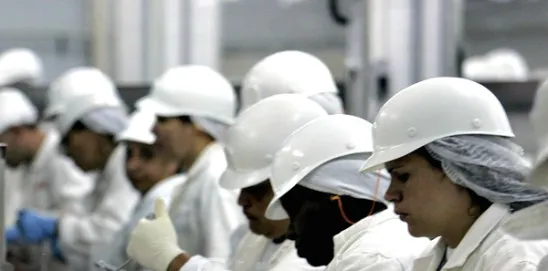As every employer grappling with the global pandemic can attest, preventing and combatting occurrences of COVID-19 are paramount considerations. This concern has become all the more pronounced, and visible to the nation, with the increasing reports of COVID-19 outbreaks at food processing facilities throughout the country. In response to this potential threat to the nation’s food supply, the Occupational Safety and Health Administration (“OSHA”) and Centers for Disease Control (“CDC”) recently issued joint guidance for meat and poultry processing facilities proposing precautionary measures these employers can take to protect their workers and, in turn, the food supply.
I. Meat and Poultry Workers
The OSHA-CDC guidance makes clear that workers in meat and poultry processing are not exposed to COVID-19 through the meat products they handle. Instead, the work environment may contribute to their risk of exposure. While not entirely unique to the meat processing industry, certain of the distinctive features that OSHA-CDC noted as affecting meat and poultry workers’ risk for COVID-19 include:
-
Limited Distance Between Workers: meat and poultry processors often work in close proximately to one another on processing lines, as well as when clocking in or out or when in locker/changing rooms.
-
Long Shifts: meat and poultry workers often have extended duration of contact between one another, as they often work 10-12 hour shifts.
-
Type of Contact: meat and poultry processing workers may be exposed to the virus through respiratory droplets in the air, from contact with contaminated surfaces or objects, and limited shared common spaces.
-
Transportation: meat and poultry workers may, like other workers, engage in the common practice of ride-sharing or carpooling to work, or take public transportation, which may increase risk of contracting the virus.
II. COVID-19 Assessment and Control Plan
To mitigate these risks, OSHA-CDC recommend that food processing companies identify a qualified workplace coordinator to be responsible for all COVID-19 assessment and control planning. The workplace coordinator and management should be in contact with state and/or local public health and occupational safety and health professionals to ensure they are receiving up-to-date information.
OSHA-CDC suggest that employers conduct work-site assessments periodically to identify COVID-19 risks and prevention strategies. As a part of these assessments, facilities should consider the appropriate role for testing and workplace contact tracing of COVID-19 positive workers.
A. Engineering Controls
The joint guidance for meat processing facilities follows the existing “hierarchy of controls” approach. OSHA-CDC recommend the following list of engineering controls, all designed to isolate individuals as much as possible from the potential hazard of COVID-19:
-
Configure communal work environments so that workers are spaced at least 6 feet apart, if possible. This may necessitate changes in production practices to ensure appropriate distancing.
-
Modify workstation alignment, including along processing lines (if feasible), so that workers are at least six feet apart in all directions, when possible. Ideally, modify the workstations that so workers are not face-to-face with each other.
-
Consider using markings and signs to remind workers to maintain their location at their workstation away from each other.
-
Use physical barriers, such as strip curtains, plexiglass, or similar materials, or other impermeable dividers or partitions, to separate processing workers from each other, if feasible.
-
Consider consultation with a heating, ventilation, and air conditioning engineer to ensure adequate ventilation in work areas.
-
Where a facility uses pedestal or hard mounted fans, take steps to minimize air from fans blowing from one worker directly at another.
-
Remove personal cooling fans from the workplace (but employers must remain aware of, and take steps to prevent, heat hazards).
-
Place handwashing stations or hand sanitizers with at least 60% alcohol in multiple locations to encourage hand hygiene. If possible, choose hand sanitizer stations that are touch-free.
-
Add additional clock in/out stations, if possible, that are spaced apart, to reduce crowding in these areas.
-
Remove or rearrange chairs and tables, or add partitions to tables, in break rooms and other areas workers may frequent to increase worker separation.
-
Identify alternative areas to accommodate overflow volume, such as training and conference rooms, or using outside tents for break and lunch areas.
B. Administrative Controls
OSHA-CDC also recommend that employers implement the following administrative controls to promote social distancing and reduce the potential spread of the virus:
-
Encourage single-file movement with a six foot distance between each worker through the facility, where possible.
-
Designate certain workers to monitor and facilitate distancing on processing floor lines.
-
Stagger break times and workers’ arrival and departure times to avoid congregations of workers in common areas.
-
Consider cohorting (grouping together) workers, which may minimize the number of different individuals who come into close contact with one another over the course of a workweek.
-
Offer temporary break areas and restrooms to avoid groups of workers during breaks, and maintain social distancing while on break times.
-
Consider building additional short breaks into staff schedules to increase how often they can practice hand hygiene.
-
Provide visual cues (e.g., floor markings or signs) to remind workers to maintain six feet of separation between each other.
-
If possible, encourage workers to avoid carpooling to and from work.
-
Where carpooling or using company shuttle vehicles is a necessity for workers, the number of people per vehicle should be limited as much as possible. Employees should use hand hygiene before entering the vehicle and when arriving at the destination, should wear cloth masks in the vehicle, and clean and disinfect commonly touched vehicle surfaces (e.g., door handles, handrails, seatbelts).
-
Monitor and respond to absenteeism at the workplace.
-
Manage sick workers. Immediately separate and send home workers who appear to have COVID-19 symptoms upon arrival at work or during the work day. Disinfect that individual’s workstation and any tools he or she handled.
-
Personnel managing sick employees should be appropriately protected from exposure.
-
In areas where community transmission of COVID-19 is occurring, consider developing and implementing a comprehensive screening and monitoring strategy aimed at preventing the introduction of COVID-19 into the worksite.
-
Review leave and incentive policies to make sure ill workers are not in the workplace nor penalized for taking sick leave if they have COVID-19.
-
Establish a system for employees to alert their supervisors if they are experiencing signs or symptoms of COVID-19 or have had recent close contact with a suspected or confirmed case of COVID-19.
-
Supplement workers’ normal and required job training with additional training and information about COVID-19, recognizing signs and symptoms of infection, proper handwashing, cough/sneeze etiquette, and other ways to prevent exposure to the virus.
-
Post simple posters in all of the languages commonly used by the workforce that encourage staying home when sick, cough and sneeze etiquette, and proper hand hygiene practices. Posters should be at the entrance to the workplace and in break areas, locker rooms, and other workplace areas where they are likely to be seen.
-
If cloth masks are worn at the facility, provide readily available clean cloth face coverings (or disposable facemask options) for workers to use when the coverings become wet, soiled, or visibly contaminated.
C. Sanitation Controls
As part of its recommendations on cleaning and disinfection, the joint guidance recommends that, for tool-intensive operations, food processing facilities should regularly clean and disinfect tools, at least as often as workers change workstations or move to a new set of tools. The guidance also provides that employers should establish protocols and provide supplies to increase the frequency of sanitation in work and common spaces. OSHA-CDC recommend disinfecting frequently touched surfaces in workspaces and breakrooms (e.g., microwave, refrigerator handles, vending machine touchpad) at least once per shift, if possible.
As the guidance reminds employers, workers who perform cleaning and disinfection tasks may require additional personal protective equipment (“PPE”) and other controls to protect them from chemical hazards posed by disinfectants.
D. Personal Protective Equipment
Employers should also consider requiring PPE. Employers must conduct a hazard assessment to determine if hazards are present, or are likely to be present, for which workers need PPE. As part of their hazard assessments, employers must always consider whether PPE is necessary to protect workers. Specifically, when engineering and administrative controls are difficult to maintain and there may be exposure to other workplace hazards, such as splashes or sprays of liquids on processing lines or disinfectants used for facility cleaning, PPE should be considered.
III. Conclusion
Food processing facilities are likely already utilizing many of the safety controls contained in the new federal guidance. For those that are not, or those that have not assessed their safety controls recently, this new guidance reiterates the steps that food processing employers should consider and/or implement to mitigate the risk of a COVID-19 outbreak in such a critical industry. At a minimum, these facilities should assess their existing workplaces to consider (i) how to reconfigure or modify existing workspaces to limit cross-contamination between workers; (ii) whether to modify work schedules and processing/production lines to maximize social distancing; and (iii) increasing the frequency of cleaning and disinfection of tools, equipment, and common surface areas.
As you are aware, things are changing quickly and there is no clear-cut authority or bright line rules. This is not an unequivocal statement of the law, but instead represents our best interpretation of where things currently stand. This article does not address the potential impacts of the numerous other local, state and federal orders that have been issued in response to the COVID-19 pandemic, including, without limitation, potential liability should an employee become ill, requirements regarding family leave, sick pay and other issues



 />i
/>i

